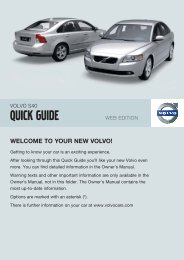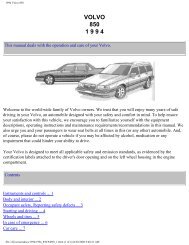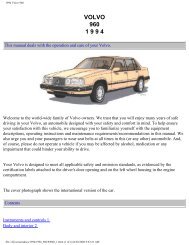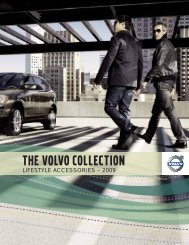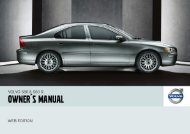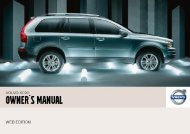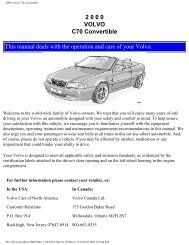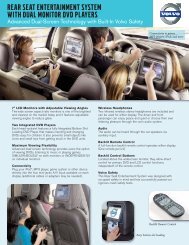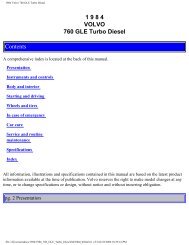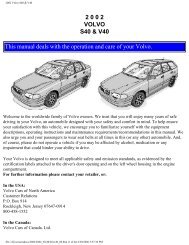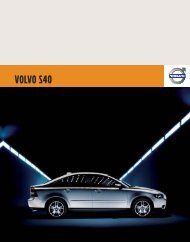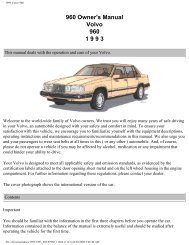V50 w646.book - ESD - Volvo
V50 w646.book - ESD - Volvo
V50 w646.book - ESD - Volvo
Create successful ePaper yourself
Turn your PDF publications into a flip-book with our unique Google optimized e-Paper software.
06 Starting and driving<br />
Brake system<br />
06<br />
Brake servo<br />
If the car is rolling or is being towed with the<br />
engine turned off, the brake pedal must be<br />
pressed about five times harder than when<br />
the engine is running. If the brake pedal is<br />
pressed when the engine is started, you will<br />
feel the pedal drop. This is normal and due to<br />
the brake servo becoming active. This may<br />
be more noticeable if the car has emergency<br />
brake assistance (EBA).<br />
WARNING<br />
The brake servo only works when the engine<br />
is running.<br />
NOTE<br />
If braking with the engine switched off,<br />
press the brake pedal sharply once, not repeatedly.<br />
Brake circuits<br />
This symbol lights if a brake circuit<br />
is not working.<br />
If a fault should occur in one of the<br />
circuits, it is still possible to brake<br />
the car. The brake pedal will travel further<br />
and may feel softer than normal. Harder<br />
pressure on the pedal is needed to produce<br />
the normal braking effect.<br />
Dampness can affect braking characteristics<br />
Brake components become wet when the<br />
car is driven in heavy rain, through pools of<br />
water or when the car is washed. This may<br />
alter brake pad friction characteristics so that<br />
there is a delay before braking effect is noticed.<br />
Press the brake pedal lightly from time to<br />
time if driving for long stretches in rain or<br />
slushy snow, as well as after setting off in<br />
very damp or cold weather. This warms up<br />
the braking surfaces and dries off any water.<br />
It is also recommended to do this before<br />
parking the car for a long period in such<br />
weather conditions.<br />
If the brakes are used heavily<br />
When driving in the Alps or other roads with<br />
similar characteristics, the car’s brakes are<br />
heavily loaded even if the brake pedal is not<br />
being depressed especially hard.<br />
Because speed is often low, the brakes are<br />
not cooled as effectively as when driving on<br />
flat roads at higher speed.<br />
So as not to overload the brakes, shift down<br />
when driving downhill instead of using the<br />
foot brake. Use the same gear driving downhill<br />
as you would use driving uphill. This uses<br />
engine braking more efficiently and requires<br />
the foot brake for only brief periods.<br />
Bear in mind that driving with a trailer puts an<br />
additional load on the car’s brakes.<br />
Anti-lock braking system (ABS)<br />
The anti-lock braking system (ABS)<br />
prevents the wheels from locking<br />
up under braking.<br />
This means the ability to steer is<br />
maintained and it is easier to swerve to avoid<br />
a hazard, for example.<br />
After the engine has been started, the ABS<br />
will perform a brief self-test at a speed of<br />
about 20 km/h. This can be felt and heard as<br />
pulses in the brake pedal.<br />
To get the most out of the ABS:<br />
1. Depress brake pedal with full force. Pulses<br />
will be felt.<br />
2. Steer the car in the direction of travel.<br />
Do not release the pressure on the<br />
pedal.<br />
Practice braking with the ABS system in a<br />
traffic-free area and in different weather conditions.<br />
The ABS symbol illuminates for two seconds<br />
if there was a fault in the ABS system when<br />
the engine was last running.<br />
128



